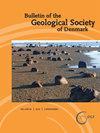与扫描和透射电子显微镜中粉笔颗粒表面研究相关的解释挑战
IF 1
4区 地球科学
Q2 Earth and Planetary Sciences
引用次数: 1
摘要
扫描和透射电子显微镜(SEM和TEM)能够表征附着在白垩颗粒表面的亚微米大小物质的形态和结构。然而,某些特性可能源于样品制备或反映样品与电子束之间的相互作用。对表面特征的错误解释可能导致对颗粒表面性质和胶结程度的错误结论,从而导致对油气藏的润湿性、机械强度和最大埋藏深度等方面的错误描述。在扫描电镜中,导电涂层可能会掩盖表面细节或产生人工装饰,碳粘片可能会使粉笔表面覆盖一层薄薄的碳膜。电子束加速电压控制着电子束显示的细节程度,但在扫描电镜中,高电子束加速电压可能引起超薄颗粒的弯曲或卷曲。最近的有机细丝可能与粘土薄片混淆,自生的非碳酸盐矿物可能在孔隙流体中形成,并在流体去除过程中沉淀下来。在TEM中,高加速电压会引起方解石的束损伤,使最外层原子层转变为氧化钙。透射电镜观察到的薄石墨膜可能是由支撑样品的碳膜污染的,而悬浮液干燥后形成的样品中重叠的白垩颗粒可能给人以胶结在一起的印象。在透射电镜中,离子铣削过程中残留的粘合剂可能与胶结特征混淆。本文章由计算机程序翻译,如有差异,请以英文原文为准。
Interpretational challenges related to studies of chalk particle surfaces in scanning and transmission electron microscopy
Scanning and transmission electron microscopy (SEM and TEM) are capable of characterising the morphology and structure of sub-micron size substances attached to chalk particle surfaces. Some characteristics, however, may originate from sample preparation or reflect interaction between sample and the electron beam. Misinterpretation of surface features may lead to wrong conclusions regarding grain surface properties and cementation level and thus to erroneous characterisation of hydrocarbon
reservoirs with respect to e.g. wettability, mechanical strength and maximum burial depth. In SEM, conductive coatings may mask surface details or generate artificial ornamentations, and carbon adhesive discs may cause the chalk surface to be covered with a thin carbon film. Electron beam acceleration voltage controls the degree of detail revealed by the electron beam, but in SEM a high electron beam acceleration voltage may provoke bending or curling of ultrathin particles. Recent organic filaments
may be confused with clay flakes, and authigenic non-carbonate minerals may have formed in the pore fluid and settled during fluid removal. In TEM, the high acceleration voltage may cause beam damage to calcite and transform the outermost atomic layers into Ca oxide. Thin graphite membranes observed by TEM may be contamination from the carbon film supporting the sample, and overlapping chalk particles in samples formed by drying of a suspension may give the impression of being cemented together. In TEM residual adhesive from the ion-milling process can be confused with cementation features.
求助全文
通过发布文献求助,成功后即可免费获取论文全文。
去求助
来源期刊

Bulletin of the Geological Society of Denmark
GEOSCIENCES, MULTIDISCIPLINARY-
CiteScore
2.80
自引率
16.70%
发文量
28
审稿时长
>12 weeks
期刊介绍:
The Bulletin publishes contributions of international interest in all fields of geological sciences on results of new work on material from Denmark, the Faroes and Greenland. Contributions based on other material may also be submitted to the Bulletin if the subject is of relevance for the geology of the area of primary interest.
 求助内容:
求助内容: 应助结果提醒方式:
应助结果提醒方式:


